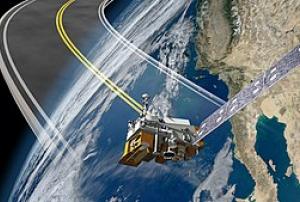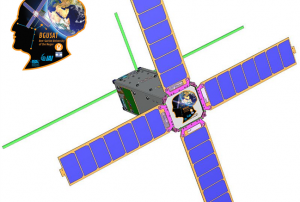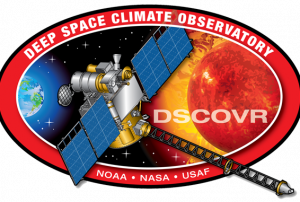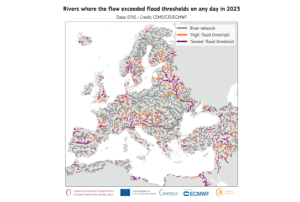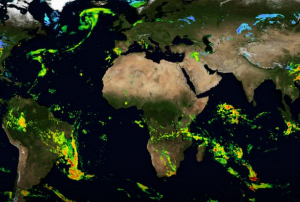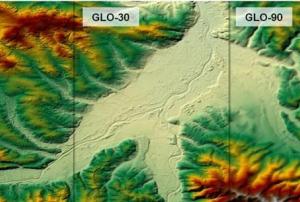Climatological
Definition
UN-SPIDER Regional Support Offices with hazard-specific expertise
Related content on the Knowledge Portal
NOAA-20, designated JPSS-1 prior to launch, is the first of the United States National Oceanic and Atmospheric Administration's latest generation of U.S. polar-orbiting, non-geosynchronous, environmental satellites called the Joint Polar Satellite System. NOAA-20 was launched on 18 November 2017 and joined the Suomi National Polar-orbiting Partnership satellite in the same orbit. NOAA-20 operates about 50 minutes ahead of Suomi NPP, allowing important overlap in observational coverage. Circling the Earth from pole-to-pole, it crosses the equator about 14 times daily, providing full global coverage twice a day. This will give meteorologists information on "atmospheric temperature and moisture, clouds, sea-surface temperature, ocean color, sea ice cover, volcanic ash, and fire detection" so as to enhance weather forecasting including hurricane tracking, post-hurricane recovery by detailing storm damage and mapping of power outages.
The project incorporates five instruments,…
read more18/11/2017The research Nanosatellite BGUSAT, the first of Israel, was launched from India in February 2017 as a part of a collaboration between the Ben-Gurion University of the Negev and the Aerospace Industries. Nanosatellites are a relatively new category in the field of satellites and space. These tiny satellites only weigh a few kilograms. Thanks to the minimization trend of electronic components, this platform can be instilled with advanced technological abilities for a fairly low price. The satellite is tiny- only 10X30 centimeters, the size of a milk carton, and weighs only 5 kilograms. It is equipped with cameras able to identify different climatic phenomena, and with a control system that allows selection of the research and photography areas. Ground-station for reception of the images was built in the university, allowing students and researchers to receive and analyze the data.
15/02/2017- 02/11/2016
Peru’s first Earth Observation satellite was commissioned by the Peruvian government for its national space agency, CONIDA (Comisión Nacional de Investigación y Desarrollo Aeroespacial) in 2014, and constructed in a record time of less than 24 months. PerúSAT-1 features the very-high-resolution optical New AstroSat Optical Modular Instrument (NAOMI) imager designed and developed by Airbus Defence and Space. This silicon carbide optical instrument provides panchromatic images with 70 cm spatial resolution and multispectral images in up to 2 m spatial resolution. PerúSAT-1 is based on Airbus Defence and Space’s AstroBus-S platform, and captures up to 300 images covering an area of 63, 000 km2 per day.
16/09/2016DSCOVR (Deep Space Climate Observatory) is an American space weather station developed in partnership with NASA, NOAA, and the U.S. Air Force, that monitors changes in the solar wind, providing space weather alerts and forecasts for geomagnetic storms that could disrupt power grids, satellites, telecommunications, aviation, and GPS. DSCOVR orbits approximately 1.5 million km from Earth in a unique location called Lagrange point 1 (L1), the neutral gravity point between the Earth and Sun.
Instruments:
• Plasma-Magnetometer (PlasMag): Magnetometer and plasma sensor to measure solar wind properties for forecasting geomagnetic storms. The PlasMag instrument comprises a Faraday Cup (measures solar wind) and a Fluxgate Magnetometer, as well as two space weather instruments: the Electron Spectrometer and the Pulse Height Analyzer.
• Earth Polychromatic Imaging Camera (EPIC): Provides images ofthe sunlit side…
read more11/02/2015Himawari 8 is a Japanese weather satellite, the 8th of the Himawari geostationary weather satellites operated by the Japan Meteorological Agency. The spacecraft was constructed by Mitsubishi Electric with assistance from Boeing, and is the first of two similar satellites to be based on the DS-2000 satellite bus. Himawari 8 entered operational service on 7 July 2015 and is the successor to MTSAT-2 (Himawari 7) which was launched in 2006.
07/10/2014- 01/08/1996
The Copernicus Climate Change Service (C3S), along with the World Meteorological Organization (WMO) have recently released their 2023 European State of the Climate report (ESOTC 2023), which included a number of key findings in regards to the climatological conditions around Europe, including and overview of the extensive flooding and temperature conditions around the region.
Along with a variety of maps detailing the differential coverage and intensity of these conditions, they have found that the temperatures in Europe were above average for 11 months of the year, and a third of the river networks exceeded the ‘high’ flood threshold (with 16% reaching the ‘severe’ flood threshold).
In a press release containing an overview of the report, the organizations discussed a number of topics including the general trend of climate change and warming temperatures, the subsequent health impacts these may have on the people in Europe, a brief discussion on the seasonal…
read more06/05/2024- read more
This three-part webinar series hosted by the International Precipitation Working Group (IPWG) and Global Precipitation Measurement (GPM) Applications Program will focus on the use of GPM data products for applications. Specifically, the participant will learn more about how to access GPM data and will be provided demonstrations on precipitation data access and analysis using NASA's Giovanni tool and Google Earth Engine.
To receive a certificate of completion, the participant will need to attend all three sessions of this training program.
Topics Covered:
- Review the TRMM / GPM Missions
- Become familiar with GPM data access and…
- The Copernicus DEM is a Digital Surface Model (DSM) which represents the surface of the Earth including buildings, infrastructure, and vegetation. The Copernicus DEM is provided in 3 different instances. Two worldwide coverages at 90m (GLO-90) and 30m (GLO-30) resolution are openly available to the public for download via the PANDA Catalogue and FTP. A further European coverage (EEA-10) is provided at 10m resolution, but data is restricted to eligible users who meet required access rights.Publishing institution:
